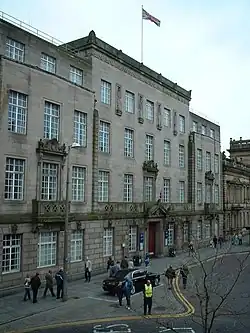Preston Town Hall
Preston Town Hall is a municipal building in Lancaster Road in Preston, Lancashire, England. The town hall, which is the headquarters of Preston City Council, is a Grade II listed building.[1]
| Preston Town Hall | |
|---|---|
 The current Preston Town Hall (originally the municipal office building) | |
| Location | Lancaster Road, Preston, Lancashire |
| Coordinates | 53.7599°N 2.6988°W |
| Built | 1934 |
| Architect | Sir Arnold Thornely |
| Architectural style(s) | Neoclassical style |
Listed Building – Grade II | |
| Official name | Town Hall, Lancaster Road |
| Designated | 20 December 1991 |
| Reference no. | 1207297 |
 Shown in Lancashire  Location in Preston | |
History
.jpg.webp)
The first town hall was a medieval structure built on the south side of the Market Square which collapsed in June 1780.[2][3] It was replaced by a second town hall which was a brick building built on the same site in 1782 and augmented by a cupola in 1814.[2]
After significant industrial growth in the first half of the 19th century, particularly in relation to the cotton industry, civic leaders decided to procure a third town hall on the same site.[4] The foundation stone for the new building was laid by the mayor, Robert Townley Parker, on 2 September 1862.[5] It was designed by George Gilbert Scott in the Gothic style, built by Cooper and Tullis of Preston at a cost of £69,412 and was officially opened by the Duke of Cambridge on 3 October 1867.[4][6][7] The design involved arcading on the ground floor and tracery windows on the first floor and it featured a tower at the south west corner which was 197 feet (60 m) high.[4][8] The tower housed a Cambridge-chiming clock by William Potts & Son,[9] with bells by Taylor of Loughborough;[10] at the time it was one of the largest gravity-escapement clocks to have been made in England.[9]
As the responsibilities of the borough council increased, council leaders decided to procure a municipal office building to provide extra office space for council officers and their departments: the site selected was open ground in Lancaster Road between the police station to the north and the Sessions House to the south.[11] The municipal office building, which was designed by Sir Arnold Thornely in the Neoclassical style was completed in 1934.[1] The design involved a symmetrical main frontage with eleven bays facing onto the Lancaster Road with the last three bays at each end slightly projected forward; the central section of five bays, which rose higher than the end sections, featured a doorway with an architrave and a pediment decorated with acroteria; in each of the sections the centre window on the first floor was equipped with a balcony.[1]
As part of a two-day visit to Lancashire, King George VI and Queen Elizabeth attended a lunch hosted by the Lord Lieutenant of Lancashire, Lord Derby, at County Hall before meeting civic leaders at the town hall in March 1945 during the Second World War.[12]
The town hall burnt down on 15 March 1947 and was subsequently demolished and a modern building known as Crystal House was built on the site in 1962.[13] A council chamber was created in the municipal office building which was renamed the Preston Town Hall in 1971.[2] The new town hall continued to be the local seat of government after the enlarged Preston District Council was formed in 1974[14] and remained its home after the local authority secured city status as Preston City Council in 2002.[15]
References
- Historic England. "Town Hall, Lancaster Road (1207297)". National Heritage List for England. Retrieved 29 November 2020.
- "Night flames tore through city's finest landmark". Lancashire Post. 17 March 2017. Retrieved 29 November 2020.
- Farrer, William; Brownbill, J. (1912). "'The parish of Preston', in A History of the County of Lancaster". London: British History Online. pp. 72–91. Retrieved 30 November 2020.
- "Preston Town Hall, Market Square, Preston". Gilbertscott.org. Retrieved 29 November 2020.
- "Past Mayors" (PDF). Visit Preston. Retrieved 29 November 2020.
- "Preston, Lancashire". Local Histories. Retrieved 29 November 2020.
- "History of Preston". BBC. Retrieved 29 November 2020.
- Swarbrick, Paul. "Preston Past: Sir George Gilbert Scott's Preston Town Hall". Preston Historical Society. Retrieved 29 November 2020.
- Potts, Michael S. (2006). Potts of Leeds: Five Generations of Clockmakers. Ashbourne, Derbyshire: Mayfield Books. pp. 47–49.
- Snowdon, Jasper W. (1888). Grandsire: the Method, Its Peals, and History. London: Wells Gardner, Darton & Co. p. 207.
- "Ordnance Survey Map". 1912. Retrieved 29 November 2020.
- "Details of a Secret Royal Visit to Preston". Lancashire Post. 6 March 2020. Retrieved 14 November 2020.
- "Readers' Recollections...fire at the Town Hall, 1947". Lancashire Telegraph. 4 June 1999. Retrieved 14 November 2020.
- Local Government Act 1972. 1972 c.70. The Stationery Office Ltd. 1997. ISBN 0-10-547072-4.
- "'Proud Preston' wins city status". BBC. 14 March 2002. Archived from the original on 22 August 2007. Retrieved 6 June 2006.
